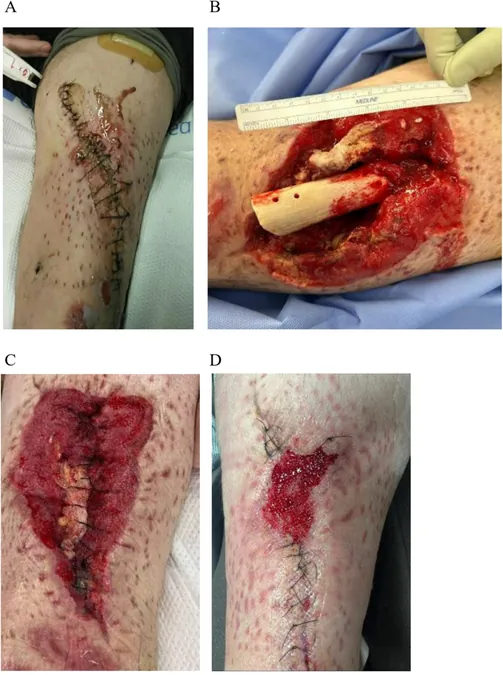
Unraveling a Medical Mystery: Rare Infections in a Young Ehlers-Danlos Syndrome Patient After a Traumatic Accident
2024-09-27
Unraveling a Medical Mystery: Rare Infections in a Young Ehlers-Danlos Syndrome Patient After a Traumatic Accident
A 26-year-old man, diagnosed with Ehlers-Danlos Syndrome (EDS), is at the center of a fascinating yet alarming medical case following a serious car accident in Arizona. The incident resulted in severe trauma to his left leg, leading to multiple surgeries including a below-knee amputation and the placement of a femoral intramedullary nail. After spending three weeks hospitalized, he was discharged with antibiotics to fight potential infections. However, trouble was just beginning.
Just days after returning home, the patient was back in the emergency room complaining of excruciating pain in his left leg, accompanied by foul-smelling drainage from his surgical site. An urgent medical evaluation revealed extensive tissue infection, necessitating immediate surgical debridement. The affected area of flesh measured 44 cm by 15 cm, characterized by significant purulence. Shockingly, no antibiotics were given prior to this invasive procedure.
In the operating room, cultures performed on the infected tissue revealed two unusual pathogens: Priestia endophytica, and Mycobacterium goodii. Initially, there was concern that Bacillus anthracis, the microorganism responsible for anthrax, could be involved. However, advanced molecular testing provided reassurance, ruling it out. Instead, Priestia endophytica, previously recognized as Bacillus endophyticus, and M. goodii, both stemmed from the patient’s infected tissue, hinting at the complex nature of his health issues.
In treating the infections, the healthcare team adopted a multitiered antibiotic protocol. Initially, the patient received vancomycin but switched to daptomycin due to ineffective levels of the first drug. Meanwhile, targeted antibiotic therapy for Priestia endophytica had a promising start, and as the infections unfolded, antibiotics evolving from susceptibility testing proved effective. Over the next few weeks, the patient underwent repeated incision and drainage procedures. Remarkably, shortly after beginning a combination of daptomycin and doxycycline, the wound started to heal.
Conventional culture protocols also revealed the presence of Mycobacterium goodii, a rapid-growing, acid-fast mycobacterium often associated with post-surgical infections and complicated wound management. This particular bacterium poses challenges due to its environmental ubiquity; it is a common inhabitant of soil, dust, and water, complicating the clinical picture of infections that follow traumatic injuries. Treatment concerns mounted with the limited clinical experience surrounding M. goodii, as it displayed a unique susceptibility profile, with a proven tendency toward resistant strains in some infections.
During this complicated recovery process, further testing of the patient’s immune system uncovered decreased levels of natural killer (NK) cells, raising red flags about his immune health. Such findings suggested potential dysfunction in his innate immune response, requiring additional immunological assessments to understand better how EDS might compromise his susceptibility to rare infections.
Interestingly, Priestia endophytica is primarily recognized for enhancing plant growth but its identification as a potential human pathogen is unprecedented. The strain's physical characteristics could easily veer into confusion with Bacillus anthracis, further complicating diagnosis in clinical settings. This case, while illustrative of unique microbial interactions, also reinforces ongoing concerns regarding antibiotic resistance and the necessity for careful selection of treatment regimens, especially in patients with predisposed conditions like EDS.
EDS patients often face a variety of health challenges due to their connective tissue abnormalities, which can manifest in less effective healing processes and, as seen here, complications with infections. Therefore, knowing that this group may have higher incidence rates of unusual pathogens is crucial for healthcare providers to consider, especially in post-surgical recovery scenarios.
In conclusion, this young patient’s journey sheds light on rare infections and complex medical conditions, highlighting the need for comprehensive care tailored to individual health nuances. It underscores the importance of continual medical research, especially as we encounter novel bacterial infections in unconventional contexts. As complications arose, the interplay of unique underlying health issues and emerging pathogens brought to light the necessity of advance planning in patient care strategies, marking a significant learning opportunity for the medical community.




 Brasil (PT)
Brasil (PT)
 Canada (EN)
Canada (EN)
 Chile (ES)
Chile (ES)
 España (ES)
España (ES)
 France (FR)
France (FR)
 Hong Kong (EN)
Hong Kong (EN)
 Italia (IT)
Italia (IT)
 日本 (JA)
日本 (JA)
 Magyarország (HU)
Magyarország (HU)
 Norge (NO)
Norge (NO)
 Polska (PL)
Polska (PL)
 Schweiz (DE)
Schweiz (DE)
 Singapore (EN)
Singapore (EN)
 Sverige (SV)
Sverige (SV)
 Suomi (FI)
Suomi (FI)
 Türkiye (TR)
Türkiye (TR)